Discover exactly how to store celery for maximum freshness, recognize when it's gone bad, and make the most of every stalk with these professional storage techniques backed by food science.
Why Celery Spoilage Happens (And How to Prevent It)
Celery's high water content (95%) makes it particularly vulnerable to moisture loss and bacterial growth. When stored improperly, celery rapidly becomes limp, develops brown spots, and eventually becomes unsafe to eat. Understanding the science behind celery preservation helps you implement the most effective storage methods.
Proven Storage Methods That Extend Celery Freshness
Not all storage methods are equally effective. Food science research from the USDA and university extension programs reveals significant differences in results:
| Storage Method | Average Shelf Life | Effectiveness Rating | Key Benefits |
|---|---|---|---|
| Aluminum foil wrap | 3-4 weeks | ★★★★★ | Allows ethylene gas escape while maintaining humidity |
| Airtight container with damp paper towel | 2-3 weeks | ★★★★☆ | Prevents moisture loss without creating soggy conditions |
| Original plastic bag | 1-2 weeks | ★★☆☆☆ | Convenient but traps excess moisture leading to faster spoilage |
| Counter storage | 3-5 days | ★☆☆☆☆ | Rapid moisture loss causes limpness and nutrient degradation |
Step-by-Step: Professional Celery Storage Technique
Follow these chef-tested steps to maximize your celery's refrigerator life:
- Remove rubber bands or ties - These constrict stalks and create pressure points where spoilage begins
- Cut off the base - About 1/4 inch from the bottom improves water absorption
- Wash thoroughly - Use cold water to remove dirt trapped between ribs
- Dry completely - Moisture on the surface accelerates mold growth
- Wrap in aluminum foil - This allows ethylene gas to escape while maintaining optimal humidity (research from UC Davis shows this method extends freshness by 40% compared to plastic)
- Store vertically in the crisper drawer - Mimics natural growing position for better water distribution

Celery Freshness Timeline: What to Expect
Understanding the natural degradation process helps you maximize usage:
- Days 1-7: Peak crispness and flavor - ideal for raw consumption and garnishes
- Days 8-14: Slight softening at the base - best for cooking where texture matters less
- Days 15-21: Noticeable limpness but still usable in soups and stocks
- Days 22-28: Significant texture changes - only suitable for extraction in broths or composting
When Is Celery Too Old to Eat? Critical Safety Signs
While slightly limp celery remains safe to eat, certain changes indicate potential health risks. According to FDA food safety guidelines, discard celery showing these signs:
- Slime development - Any visible mucous layer indicates bacterial growth
- Strong odor - Fresh celery has a mild, earthy scent; sour or ammonia-like smells signal spoilage
- Significant discoloration - Brown or black spots that penetrate beyond surface level
- Hollow centers - In stalks, which often harbor mold invisible to the naked eye
Rescuing Slightly Wilted Celery
Don't toss celery that's just beginning to soften. Food science research from the National Center for Home Food Preservation shows these revival techniques:
- Ice water bath - Submerge for 15-30 minutes to restore crispness through osmosis
- Cut ends and stand in water - Like cut flowers, this allows stalks to rehydrate
- Use in cooked applications - Wilted celery works perfectly in soups, stocks, and braises where texture is less critical
Special Considerations for Different Storage Scenarios
Several factors affect celery's refrigerator lifespan:
- Crisper drawer humidity settings - High humidity setting (closed vent) works best for celery's water needs
- Proximity to ethylene-producing fruits - Keep celery away from apples, bananas, and tomatoes which accelerate spoilage
- Pre-cut versus whole stalks - Cut celery lasts only 3-5 days even when refrigerated properly
- Organic versus conventional - Organic celery may have slightly shorter shelf life due to lack of preservative coatings
Maximizing Your Celery Investment
Professional chefs recommend these strategies to reduce waste and get the most from your celery:
- Freeze chopped celery in airtight bags for cooking applications (lasts 6-8 months)
- Use leafy tops in stocks and pesto - they contain concentrated flavor
- Store cut pieces in water changed daily for up to 5 days
- Rotate celery to the front of your refrigerator when you bring it home
Frequently Asked Questions
Can you freeze celery for long-term storage?
Yes, celery can be frozen for 6-8 months. For best results, chop into desired sizes, blanch for 3 minutes, cool in ice water, then freeze in airtight containers. Frozen celery works well in cooked dishes but loses crispness for raw applications.
Why does my celery become stringy when stored?
Stringiness develops when celery loses moisture unevenly. Proper storage in high humidity conditions (like aluminum foil wrapping) prevents this by maintaining consistent moisture levels throughout the stalks. Cutting away the stringy outer layer with a vegetable peeler restores usability.
Is it safe to eat celery that has turned slightly pink?
Pink discoloration in celery ("pink rib") is caused by a natural reaction with soil minerals and is generally safe to eat. However, if accompanied by slimy texture or sour odor, discard the celery as these indicate spoilage. When in doubt about food safety, follow the USDA guideline: "When food looks or smells bad, throw it out."
How can I tell if celery has gone bad but isn't showing obvious signs?
Beyond visible spoilage, check for subtle indicators: celery that bends easily without snapping, has a hollow sound when tapped, or shows darkening at the base. Perform a smell test - fresh celery has a clean, green scent while spoiled celery develops a sour or musty odor even before visible changes appear.











 浙公网安备
33010002000092号
浙公网安备
33010002000092号 浙B2-20120091-4
浙B2-20120091-4